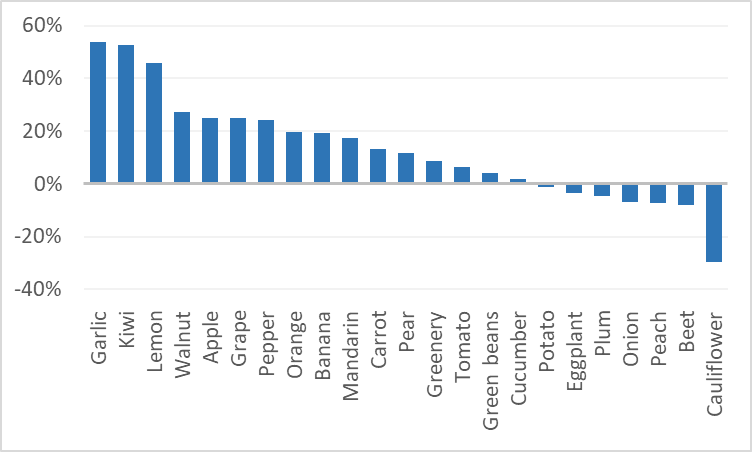Due to the lasting increases in the price levels, food prices, including those for fruit, nut, and vegetable, are gaining more and more spotlight in Georgia. Recently the Georgian government voiced concerns about the issue and decided to find solutions to the growing prices. In this article, EastFruit analysts review how much food could a Georgian average wage afford over the years.
Wage and food price indices, and how much food a wage could afford in Georgia
Average of the first three quarters of each year, 2017 taken as 100

Data source: GeoStat
Note: Fourth quarter data for wages in 2022 is not available yet, so we use the first three quarters for all years in our analysis
As we see from the chart, the average wage in Georgia has been increasing since 2017. However, the increase in the price of Georgian consumers’ food baskets outpaces the growth of salaries. As a result, the amount of food basket the average Georgian could buy shows a declining pattern. “Food afforded by wage index” equals 93 for 2022, which means that the average salary in Georgia for the first three quarters of 2022 could afford 7% less food than in the same period of 2017 (given we took the amount in 2017 to be 100).
Read also: Food prices keep growing in Georgia – the government is stepping in to find a solution
When comparing 2022 with 2017, the situation with fruits, nuts, and vegetables looks different – the trend from 2017 to 2022 is not clearly negative. GeoStat publishes data per product too, and in most cases, an average wage could afford more fruits, nuts, and vegetables than in the base period.
How much fruits, nuts, and vegetables a Georgian wage could afford
Percentage change, 2022 vs 2017

Data source: Geostat
Out of 23 fruits, nuts, and vegetables published, the average wage could afford more in 16 cases in 2022 compared to 2017. The average growth in the affordable volume for such products amounts to 22%.
The affordability of garlic, kiwis, and lemons increased exceptionally, as these three are the only products that did not cost more in 2022 than they did in 2017. Retail prices for all other products have grown on average by 40% (2022 vs 2017). However, growth in the average salary was larger in all but 7 cases, hence the average wage in Georgia could afford more fruits, nuts, and vegetables in 2022 than in 2017.
While the improvement over the base year for fruits, nuts, and vegetables is apparent, for most of the group, the affordability was not the highest in 2022. Out of 23 products from the group provided above, the amount that could be bought was maximum in only 6 cases for 2022. In the other 17 cases, the wage could buy more of a particular product in one of the earlier periods. Thus, the purchasing power of the Georgian salary was not at its peak in 2022 for the most part when it came to fruits, nuts, and vegetables. Overall, in this regard, there is no clear pattern of either growth or reduction for most products from the group throughout 2017-2022.
The use of the site materials is free if there is a direct and open for search engines hyperlink to a specific publication of the East-Fruit.com website.




